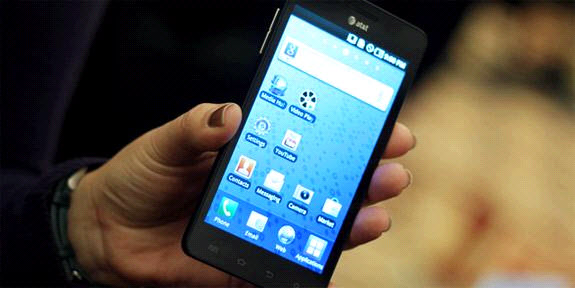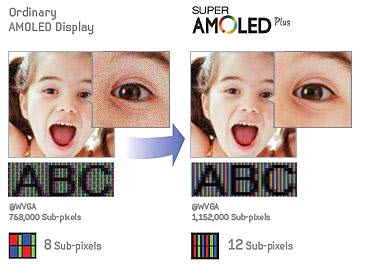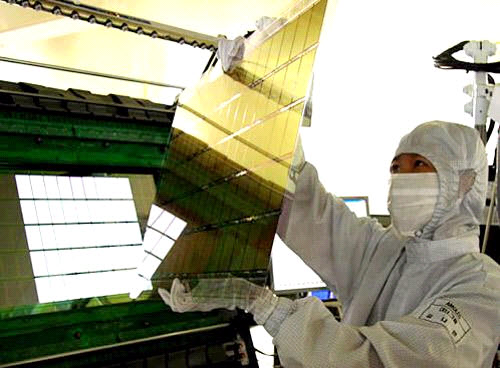The difference of the AMOLED PenTile and Real-Stripe technologies
Compared to Android device manufacturers, Samsung has the advantage of being an 'end-to-end' manufacturer, meaning that it can 'self-supply' components for the device. me Almost everything in Samsung Android phones comes from component manufacturing factories owned by Samsung's subsidiary or subsidiary. They are motivated to develop AMOLED display technology in recent years and Super AMOLED has found its way in the Samsung smartphone market.

And Samsung's latest technology is called Super AMOLED Plus . New technology for good lighting is now even better. What has changed in new technology? That's the arrangement of sub-pixels that are called PenTile and Real-Stripe. With the article below, hopefully users can realize the difference between these technologies.
The difference between PenTile and Real-Stripe

The layout of pixel points in Pentile style
All pixels of the phone are made up of many small pixels. The phone has a resolution (usually 854x480 or 800x480) measured in pixels. Each sub-pixel is given a certain color: red, dark blue or green. On Samsung's Super AMOLED screen , each pixel consists of 8 small pixels. PenTile refers to the arrangement of these elements. Unlike the standard RGB screen, PenTile is an arrangement in the style of RG-BG (Red Green-Blue Green), it repeats between alternating green colors between two dark blue and red . The screens are much easier to produce than the more difficult AMOLED capital.

The layout of pixel points in the traditional RGB style
Super AMOLED Plus will change the pixel layout, it will arrange more than other screen technologies. This screen will use pixel pixel sorting in RGB-RGB style. Samsung has decided to name this brand Real-Stripe. While each pixel in PenTile is made up of 8 sub-pixels, Real-Stripe has 12 elements. That is a 50% increase in the number of sub-pixels that Samsung arranges.
Effectiveness of the layout of pixels
When using Super AMOLED screen , if you pay close attention, you will definitely see the effect of PenTile screen. Some colors look almost particles, also known as grain breakage. This is more noticeable with warmer colors, users will see speckled marks while the text is a bit fainter. However, users still rate Super AMOLED better than the standard AMOLED screen of sharpness.

If you take a closer look at the Super AMOLED Plus screen , users will see additional working pixels. This will help users to see clearer, smudge-free pixels, and a lot more sharpness.
The drawback to Real-Stripe is that the total pixels are larger in size. That means the screen may be slightly larger to accommodate WVGA resolution. Phones using Super AMOLED screens such as Nexus S and Galaxy S are equipped with 4-inch screens. Meanwhile Infuse 4G and Galaxy S2 use Super AMOLED Plus screen which is respectively 4.5 inches and 4.3 inches in size. The increased size is due to larger pixels. And image quality is also considered much better than Super AMOLED .
Open to the future
The enhancement of Real-Stripe pixel size is Samsung's technology used to produce their screens. Samsung currently uses Fine-Metal-Mask (FMM) technology to produce Super AMOLED and Super AMOLED Plus . This is a good method but it is expensive and has an accuracy of about 15μm (micro meters). Using this technique, Samsung can only make the screen have a density of about 200ppi. It's the right choice for a 4.3-inch WVGA screen.

Samsung hopes to soon switch to laser technology, thermal imaging (laser-induced thermal imaging, LITI). As users can expect, this is a cheaper and more accurate method of producing AMOLED panels. LITI has accuracy in accuracy of about 2.5μm. As a result, Samsung hopes to be able to produce boards with more than 300ppi. Currently, iPhone 4 uses circuit boards 326ppi, which is an unexpected screen technology.
The trust of Samsung's Super AMOLED and Super AMOLED Plus technology is likely to be a worthy successor on the future of smartphone screen technology village. Vivid colors, clearer images than AMOLED standards. The remaining problems with AMOLED are slowly eroded as a new production technology. Samsung phones will definitely continue to use the most impressive screens in the near future.
You should read it
- What is Dynamic AMOLED display? Pros and cons? On which phone?
- What types of screens are Retina, LCD, AMOLED, OLED ...?
- Screen for the world's best laptop
- Samsung is about to have a laptop with a 'transparent' screen.
- Download Blacker, the app provides a black wallpaper for AMOLED monitors, completely free
- Unique wallpaper set for AMOLED screen smartphones
- Samsung quietly developed a new type of screen, possibly soon equipped on the Galaxy S11
- Samsung Galaxy Chromebook on sale at Best Buy starting April 6
May be interested
- What is HDR? What is the difference between HDR formats?
 hdr is one of the most discussed technologies on the web in the last few years. whether it is tv, movies, computer monitors and games, hdr is appearing on many devices.
hdr is one of the most discussed technologies on the web in the last few years. whether it is tv, movies, computer monitors and games, hdr is appearing on many devices. - Difference between Flutter and Java
 flutter and java are the two most popular technologies in the field of app creation. so what's the difference between flutter and java? let's find out with tipsmake.com.com!
flutter and java are the two most popular technologies in the field of app creation. so what's the difference between flutter and java? let's find out with tipsmake.com.com! - The brothers turned 7 lines of code into a $ 35 billion business empire
 the brothers patrick and john collison became one of the youngest self-made billionaires in the world by stripe - the fintech company they co-founded in 2010 currently worth $ 35 billion.
the brothers patrick and john collison became one of the youngest self-made billionaires in the world by stripe - the fintech company they co-founded in 2010 currently worth $ 35 billion. - What is the difference between Hex, RGB and HSL?
 hex, rgba and hsla are 3 of the most commonly used color codes. each color code makes sense in different situations. today's article will explain the difference between rgb, hex and hsl.
hex, rgba and hsla are 3 of the most commonly used color codes. each color code makes sense in different situations. today's article will explain the difference between rgb, hex and hsl. - Samsung is about to have a laptop with a 'transparent' screen.
 it seems that samsung is being attracted by the amoled displays throughout the company when it plans to launch a series of new products with this feature next year.
it seems that samsung is being attracted by the amoled displays throughout the company when it plans to launch a series of new products with this feature next year. - What is the difference between GUI and CLI?
 chances are you're curious about what interface to use on your operating system. or maybe you want to learn about the difference between gui and cli.
chances are you're curious about what interface to use on your operating system. or maybe you want to learn about the difference between gui and cli. - Why is the screen often black and flashing when filming?
 maybe everyone once realized that when pointing the camera to the tv screen, computer or phone to film, it will see a lot of black stripes on the screen, if you continue filming your video will be bad and almost can't watch.
maybe everyone once realized that when pointing the camera to the tv screen, computer or phone to film, it will see a lot of black stripes on the screen, if you continue filming your video will be bad and almost can't watch. - The 10 major new technologies that were recently killed have made many people regret it
 each year, we are welcomed with new technologies. however, besides, many technologies are killed and we will no longer see them in the future.
each year, we are welcomed with new technologies. however, besides, many technologies are killed and we will no longer see them in the future. - The real difference between SD Card and SSD card
 since both sd and ssd cards use solid memory and no loose components, what are the differences between them? or the big sd storage card is just like a small ssd card?
since both sd and ssd cards use solid memory and no loose components, what are the differences between them? or the big sd storage card is just like a small ssd card? - Difference between QLED and OLED TV
 qled and oled are very different technologies, each with their own strengths and weaknesses. both apply to some of the best tvs on the market.
qled and oled are very different technologies, each with their own strengths and weaknesses. both apply to some of the best tvs on the market.










 Internet Explorer 9 overcomes competitors
Internet Explorer 9 overcomes competitors Mobile IP (Mobile IP)
Mobile IP (Mobile IP) Learn about how email works
Learn about how email works Display technology of the year: Multitouch (1)
Display technology of the year: Multitouch (1) Chrome 10 hurdles about browser speed
Chrome 10 hurdles about browser speed Initially learn about WebMatrix
Initially learn about WebMatrix